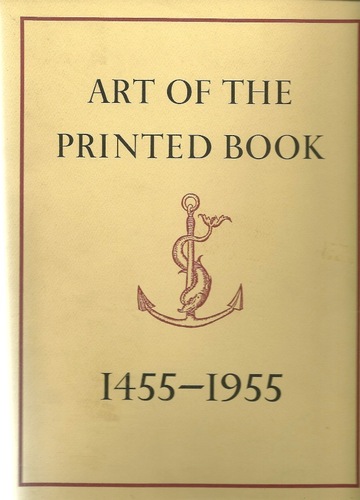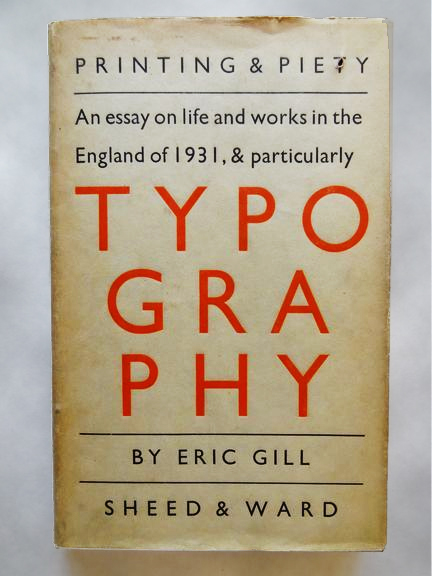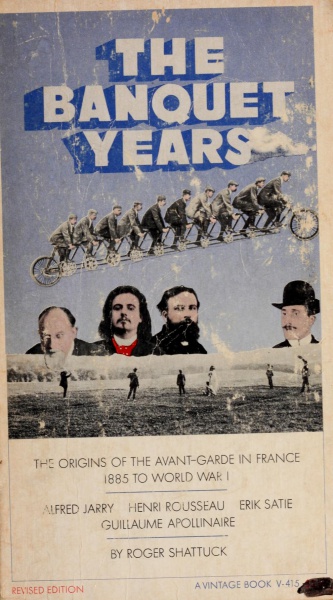Art of the Printed Book, 1455-1955 (1973)
Filed under book | Tags: · book, graphic design, print, publishing, typography

This fully illustrated volume is a fine contribution to the history of books concerned with typography and bookmaking. Neither a printing manual nor a technical treatise, it was written by an accomplished designer and printer. It includes descriptions of the lives of the important printers, Gutenberg, de Tournes, Baskerville, Aldus, etc., and presents the historical backgrounds under which their folios were made.
Art of the Printed Book was written by Joseph Blumenthal, a practitioner whose Spiral Press set a long-acknowledged standard among fine printers. It is, in one sense, a personal selection, dependent on his aesthetic standards and, in another, a testament to the discrimination and collections of the Morgan Library. The 112 books selected and reproduced range from the Gutenberg Bible to the 20th-century works of Rogers, Gill, Updike, Meynell, and Mardersteig.
Art of the Printed Book, 1455-1955: Masterpieces of Typography Through Five Centuries From the Collections of the Pierpont Morgan Library, New York
With an essay by Joseph Blumenthal
Publisher Pierpont Morgan Library, New York, and David R. Godine, Boston, 1973
Second printing, 1974
125 full-page black-and-white illustrations
192 pages
PDF (45 MB, no OCR)
Comment (0)Eric Gill: An Essay on Typography, 2nd ed. (1931/1936)
Filed under book | Tags: · graphic design, typography

An Essay on Typography was first published in 1931, instantly recognized as a classic. It represents Gill at his best: opinionated, fustian, and consistently humane. It is his only major work on typography and remains indispensable for anyone interested in the art of letter forms and the presentation of graphic information.
This manifesto, however, is not only about letters — their form, fit, and function — but also about man’s role in an industrial society. As Gill wrote later, it was his chief object “to describe two worlds — that of industrialism and that of the human workman — and to define their limits.”
His thinking about type is still provocative. Here are the seeds of modern advertising: unjustified lines, tight word and letter spacing, ample leading. Here is vintage Gill, as polemical as he is practical, as much concerned about the soul of man as the work of man; as much obsessed by the ends as by the means. (David R. Godine)
Publisher Sheed and Ward, London, 1931
Second edition, 1936
133 pages
via Araucaria
Commentary (Mark Thomson, Eye Magazine, 2006)
Planned 2014 reprint (David R. Godine)
PDF (updated to an OCR’d version on 2014-6-2 via Marcell Mars)
Comment (0)Roger Shattuck: The Banquet Years: The Origins of the Avant-Garde in France, 1885 to World War I., Rev. ed. (1955/1968)
Filed under book | Tags: · 1880s, 1890s, 1900s, 1910s, absurd, anarchism, art, art history, avant-garde, cubism, dada, dreams, france, literature, logic, montage, music history, painting, pataphysics, poetry, theatre, typography

In this book Roger Shattuck portrays the cultural bohemia of turn-of-the-century Paris who carried the arts into a period of renewal and accomplishment, and laid the ground-work for Dada and Surrealism.
“…Then came the idea–a kind of gambler’s hunch–that the trio Rousseau-Satie-Apollinaire represented several significant aspects of the period and could reveal them better than any single figure. The idea would not die. [..] Jarry had forced his way into the group and established himself close to the center of things. He helped clarify my underlying subject: how the fluid state known as bohemia, a cultural underground smacking of failure and fraud, crystallized for a few decades into a self-conscious avant-garde that carried the arts into a period of astonishingly varied renewal and accomplishment. [..] An enormous amount has been written on this era and these men since the first edition of this book in 1958. I have taken account of some of it by changing those passages where new facts have come to light.” (from the Preface to this edition)
First published in 1955
Publisher Vintage Books, 1968
397 pages
Review (Alfred Kazin, The Reporter, 1958)
Review (Sidney Tillim, College Art Journal, 1959)
Review (Justin O’Brien, The Saturday Review, 1958)
PDF (115 MB, no OCR)
Comment (0)
